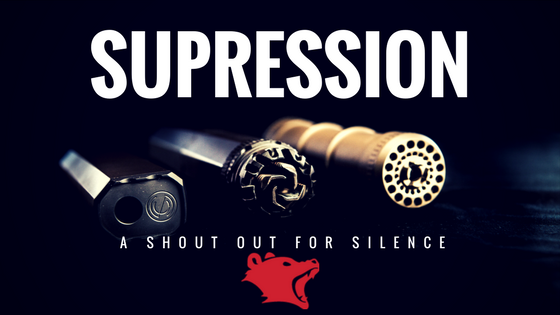
What is a silencer or a suppressor?
If you are new to the suppression for things that go boom discussion you might be a little confused at the misconceptions and mislabels that surround suppression. Not to fret. Here are a few basic definitions to start you on your way to sounding, and actually knowing what you are talking about, like an old hand at this.
Silencers vs. Suppressors. The term suppressor has become more popular in recent years simply because the original term silencer has gotten such a bad rap from Hollywood and in mainstream American Culture. Add in the fact that the sound can never truly be silenced, merely suppressed, and you can see why the one term is gaining in popularity. Silencer = Suppressor. The slang term “can” is popping up more and more as well, because a silencer looks like a beverage can. If you speak to a European they may use the terms sound moderator or muffler.
A Suppressor is really ANTYHING that minimizes the sound of a gun. There are three ways in which a gun makes sound
- When the high-temperature, high-pressure gases exit the barrel it is called the muzzle blast.
- When the projectile exceeds the speed of sound it creates a shock wave called the ballistic crack or sonic signature.
- All moving parts create mechanical noise.
Decibel reduction of Muzzle Blast
All suppressors seek to reduce the decibels produced by the muzzle blast, or change the sound enough to be unrecognizable. A two-liter plastic bottle, or oil filter serves well enough for one shot to minimize the muzzle blast. We don’t recommend using that unless you are in a pickle. And, if you are, don’t tell them we told you it would work. Good luck to you.
A quality suppressor is a tube, either round or oblong, generally made out of titanium, aluminum, or steel. The main part of the tube is an expansion chamber that allows the high-temperature gasses to decelerate and cool after they exit the end of the barrel, thereby reducing the sound. On one end there are the female threads which attach it to the male threads of a barrel.
Inside the suppressor’s expansion chamber is where the magic happens. The most commonly used designs for the inner workings are called baffles. Very simply the baffles redirect the high pressure gas, thereby venting and cooling it to reduce the noise. Then is also the new airflow concept which is the up and coming suppression star.
We will be looking into specific designs of common baffle systems and highlighting the new airflow systems in upcoming blogs. So, stay tuned...
Suppressors are typically rated for a range of calibers. Make sure you are purchasing a suppressor that will fit your firearm's caliber range.You can also purchase thread adapters that allow you to use a larger bore suppressor on smaller caliber firearms. This is best discussed with your gun broker to ensure your not purchasing something unusable for your need.
Integral suppression designs are another form of suppression where the suppressor is part of the gun’s workings and is not removable. These are becoming more popular as the technology evolves.
- Log in to post comments